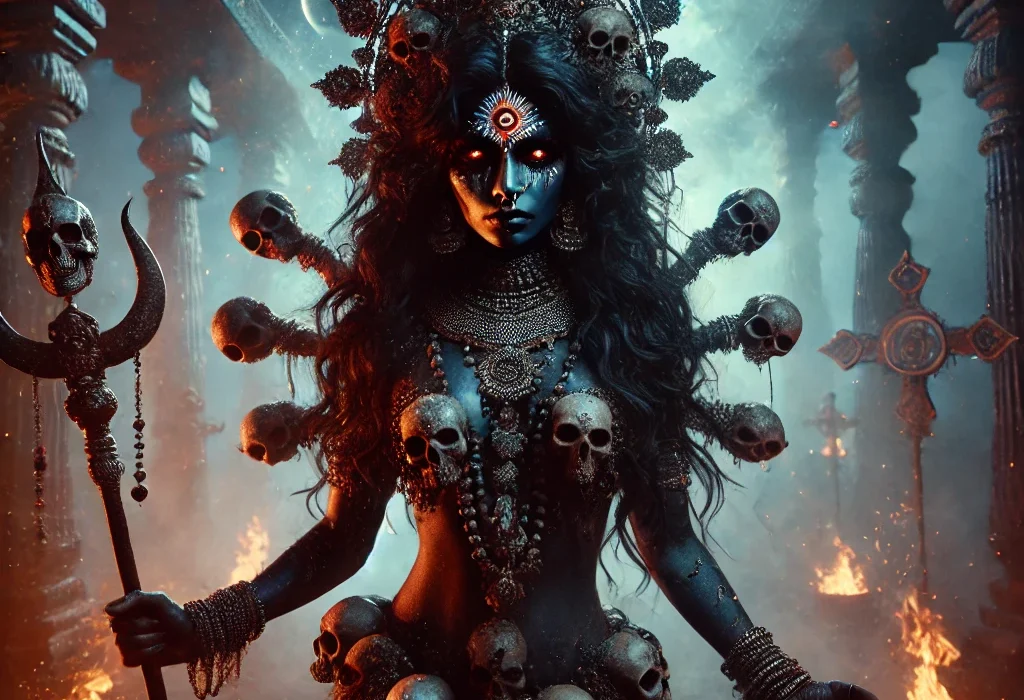Power of Shamshan Kali
Kali stands out as one of the most fascinating and revered figures. She embodies a fierce, protective energy that safeguards her devotees while also representing the inevitable aspects of life, like death and transformation. Among her many forms, Shamshan Kali—Kali of the cremation grounds—holds a special significance for those interested in the profound mysteries of existence and the path between life and death. This blog explores who Shamshan Kali is, her symbolism, and why she captivates seekers and devotees across the world.
What Does Shamshan Kali Represent?
The name “Shamshan Kali” derives from two core words: Shamshan (meaning “cremation ground” in Sanskrit) and Kali, the primal goddess representing time and destruction. Shamshan Kali is typically depicted as a dark, ferocious goddess, standing or dancing in cremation grounds, symbolizing her mastery over death and the transitory nature of life. By associating herself with the realm of death, Shamshan Kali becomes a powerful figure in Hinduism, embodying the acceptance of death as a natural part of life and spiritual transformation.
Symbolism of Shamshan Kali in Hinduism
Kali’s Connection to the Shamshan (Cremation Grounds)
For many Hindus, the cremation grounds are not merely places where the dead are laid to rest but are also sacred spaces where the veil between life and death is thinnest. It is here that Shamshan Kali resides, presiding over the cycle of creation, preservation, and destruction. By appearing in the shamshan, Kali reminds us that all forms, including our own physical bodies, are temporary and will return to the earth.
Her presence in the cremation grounds also symbolizes her role as a protector and guide of souls who have passed away, aiding them on their journey to liberation. Kali is known to sever the bonds of ego and illusion, paving the way for spiritual freedom, and nowhere is this symbolism stronger than in the shamshan.
Fierce Compassion of Shamshan Kali
At first glance, Kali’s fierce, dark, and fearsome form may appear terrifying. But beneath this exterior lies an intense compassion. As Shamshan Kali, she removes her devotees’ fears, especially the primal fear of death, helping them embrace life’s impermanence. Unlike other deities who may be gentle or reserved in their approach, Shamshan Kali confronts death head-on, embodying a compassionate force that helps her followers understand and transcend their deepest fears.
Rituals and Worship: How Shamshan Kali is Honored
In Hinduism, Shamshan Kali is revered in rituals that embrace the duality of life and death, and these often take place at night in the cremation grounds. Her followers may perform Tantric rites, meditative practices, or ceremonies with offerings that honor her as both a destroyer and a nurturer. Such rituals can be profound experiences, providing devotees a glimpse into the nature of life, death, and what lies beyond.
Tantric Practices in Worship
For those who walk the path of Tantra, Shamshan Kali is a guide through the spiritual terrain of fear, ego, and transformation. Many Tantric practitioners aim to connect with her in secluded or sacred spaces, invoking her for guidance, protection, and transcendence. The Tantric practice sees her as the ultimate reality, where life and death are seen as a continuous flow rather than opposites.
Transformative Lessons of Shamshan Kali
Accepting Mortality and Embracing Life
One of the profound teachings of Shamshan Kali is to confront and accept our mortality. By meditating on the image of Kali in the cremation grounds, devotees are reminded that death is not an end but a return to the greater whole. For many who worship Shamshan Kali, there is a desire to live life more fully, realizing that every moment is precious.
This realization often leads to a detachment from materialistic concerns and ego-driven pursuits, as devotees focus more on spiritual growth and inner transformation. Many describe the feeling of connecting with Shamshan Kali as both humbling and empowering, knowing that she watches over them with fierce compassion.
Facing and Transcending Fear
The path to connecting with Shamshan Kali is often filled with inner struggles, especially as devotees confront their deepest fears. Shamshan Kali teaches that fear itself is an illusion that holds people back from realizing their full potential. By meditating on her and embracing her teachings, practitioners learn to face their anxieties, whether they stem from loss, uncertainty, or the fear of death.
For some, working with Shamshan Kali can even be a form of psychological healing. Practitioners often recount feeling liberated after engaging in rituals dedicated to her, as they learn to let go of fear and accept life’s impermanence.
Shamshan Kali in Modern Spirituality
In today’s world, Shamshan Kali remains an icon for those looking to deepen their understanding of existence beyond superficial goals and desires. She resonates strongly with those who seek a more meaningful connection to life and a greater acceptance of death. Her teachings offer a way to face life’s challenges with courage and an open heart.
Shamshan Kali’s Place in the Modern Spiritual Landscape
Shamshan Kali offers a path of transformation for those who seek more than the comforts of material life. She calls to those willing to confront the unknown, those brave enough to ask difficult questions about life and death, and those looking to transform fear into understanding. Her symbolism, while rooted in Hinduism, speaks to universal human experiences, making her an appealing figure even in modern spirituality.
In our lives, we may not have to face physical cremation grounds, but metaphorically, Shamshan Kali reminds us that every moment is a form of rebirth and that our fears, ego, and illusions are always up for transformation. Those who honor her find themselves on a path that is as challenging as it is rewarding, seeking liberation not just in death but in every aspect of life.
Through Shamshan Kali, we learn that destruction and creation, fear and courage, life and death are all part of one great cycle—a journey where we are continually reborn, renewed, and returned to the universal whole.
